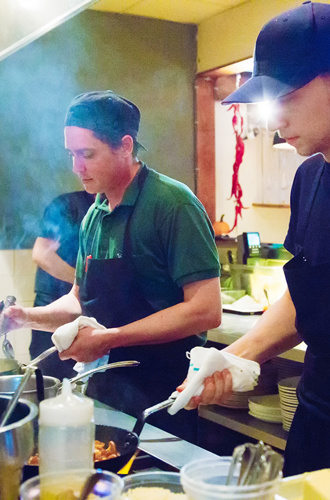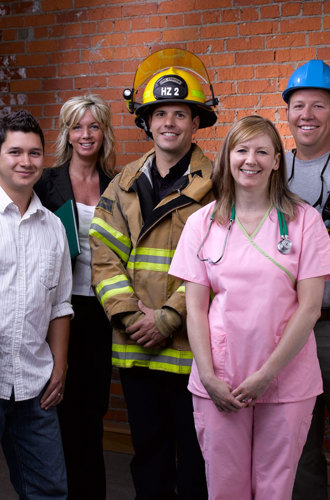Which occupations in Alberta will need more qualified workers over the next 3 years? And which are likely to have more workers than jobs?
Alberta’s Ministry of Jobs, Economy, Trade and Immigration recently released its 2024–2026 Short-Term Employment Forecast (STEF). The STEF predicts labour market conditions for 515 occupations in Alberta.
Are you planning your education, changing careers, or deciding where to upskill? Are you new to the country and unsure where you fit in? The STEF can help you choose your next steps.
What is the STEF based on?
The STEF builds on Alberta’s Occupational Outlook 2023–2033.
The Occupational Outlook starts with basic information such as age and gender. It then adds economic information. This may be related to current national events like an election, or a global event like a war. It then adds industry trends. These show where demand is growing for things like skilled construction workers or AI in health care.
From there, the Occupational Outlook looks at upcoming demand for different types of work. This may come from a growing need for a product or service or from those leaving the industry, perhaps to retire. It compares this data with numbers of new graduates in that field, new people arriving in Alberta, and workers leaving that field.
Finally, it looks at the difference between the number of projected job openings and job seekers over a 10-year period. This helps job seekers, industry leaders, policy makers, and training institutions decide how to make the most of Alberta’s work force.
What does the STEF do?
Long-term forecasts become less accurate as time goes on. This is because unpredictable events, like natural disasters and wars no matter how far away they are, can impact Alberta’s economy and labour market.
The STEF responds to this by looking at imbalances identified in the Occupational Outlook over a 3-year term. Alis’s Employment Outlook explains how it does this. In general, it accounts for factors like:
- Time of year (for seasonal jobs)
- Location (regional differences)
- Turnover (number of people leaving the occupation)
- Occupational growth (number of new positions created)
- Size of occupation (a field that employs 10,000 people will need to hire more people than one with 100 employees)
- Trends (changing ideas about the way we work or the emergence of new jobs).
Each occupation is evaluated based on:
- Scale—How many employees are needed for a type of job? How many are available?
- Severity—How many people might need to be trained or retrained to correct this mismatch?
- Trend—Over time, is this mismatch getting better (fewer new workers needed)? Or is it getting worse (many new workers still needed)?
How STEF ratings appear on alis
Alis translates the levels of demand in the STEF to a temperature scale:
- Notable shortage = Hot. There are far more jobs than job seekers.
- Mild shortage = Warm. There are more jobs than job seekers.
- Relatively balanced = Balanced. There are enough jobs for those looking for work.
- Mild surplus = Cool. There are fewer jobs than job seekers.
- Notable surplus = Cold. There are far fewer jobs than job seekers.
You’ll find the Hot, Warm, Balanced, Cool, and Cold labels in 3 places on alis:
- The Occupations in Demand page. This divides all the occupations on alis into groups. There may be only one occupation in a group or several. When you look at those with several, don’t just look at the temperature. Some occupations in that group might be Hot while others are Cool. This can skew that group’s results. You can also see the number of people currently employed in that occupational group. Clicking on each occupation will lead you to its OCCinfo occupational profile.
- The 3-Year Forecast search filter dropdown on the Occupations in Alberta page.
- The Employment & Advancement section of each occupational profile on Occinfo.
Forecast highlights
The Occupational Outlook projects an overall shortage of 8,000 to 11,000 workers in 2025. This means there will be plenty of jobs for workers who match with jobs that have a Warm or Hot outlook (assuming they have or get the required training). From 2026 onward, the Outlook predicts an overall surplus of about 8,000 workers per year.
Of the 515 occupations included in the STEF:
- 232 (45%) have a Warm or Hot outlook
- 134 (26%) have a Cool or Cold outlook
- 149 (29%) have a Balanced outlook
High demand for trades, transport, and health care
In Alberta, the sector with the most Warm or Hot job is trades, transport, and equipment operators and related occupations. Of 62 jobs in this group, 45 are likely to have too few qualified workers. So, Alberta needs skilled people to take a growing number of technology-based jobs.
As the population ages, health occupations will be in high demand. 34 out of 43 jobs in this group will need more workers than they can find locally. This is especially true for nurse aides, orderlies, patient service associates, registered nurses, and registered psychiatric nurses. All health workers must be comfortable with technological advances.
As the population grows, there will be growing need for skilled workers in construction, logistics, and transportation. These workers will help to house people. They will also help move them and the goods they need from place to place.
Across all industries, there is a growing demand for specialized skills. Certifications, diplomas, and degrees are all important. This will be true over the short and long term.
A cooler forecast for sales and service
On the other end of the scale, 34 out of 61 occupations in sales and service will likely have more job seekers than jobs. Jobs are likely to be scarce in:
- Middle management
- Food-related jobs (e.g. cooks, butchers, and bakers)
- Finance-related jobs (e.g. insurance agents and financial sales representatives)
How to use the STEF to guide your career
The STEF can help you align your education and career planning with Alberta’s labour market. Here’s how you might use the forecast at different points on your career:
- You’re a high school graduate planning to take a post-secondary degree, diploma, or certificate. Use the STEF to identify occupations likely to hire in the next couple of years. For example, in health care, training as a licensed practical nurse or paramedic could lead to strong job prospects.
- You’re a mid-career worker looking for a new challenge. As you consider options for upskilling or cross-skilling, the forecast for specific jobs can help you identify new directions. This could be in your current field or a field you could move into. For example, if you’re in a finance-related job, which is Cold, you could move into management consulting, which is Hot.
- You’re a newcomer to Canada and your qualifications aren’t valid here. The STEF can help you decide whether to upgrade your existing skills or retrain for a new field. For example, if you were a doctor in your country of origin, you might transfer to a field such as biomedical engineering, which has a Hot outlook. That might take less time and cost less than starting over with medical training.
- You would like to pursue self-employment. The first step is to figure out if your idea will succeed. The STEF can help you find out if the skills and services you plan to offer will be in demand. If not, perhaps you should switch to a related field. For example, a business journalist might become a marketing or public relations consultant. This business would offer similar earnings and a Warm outlook.





